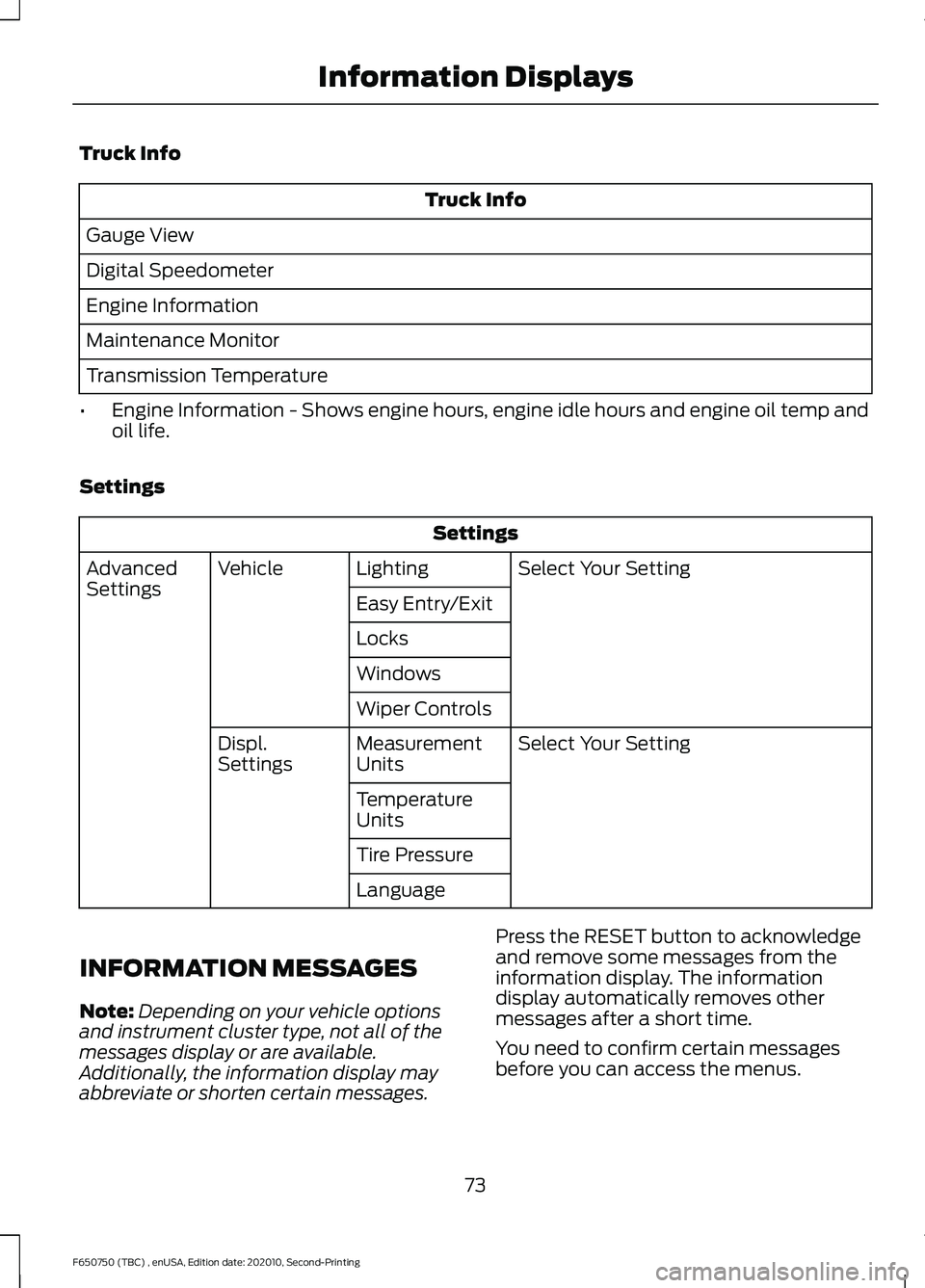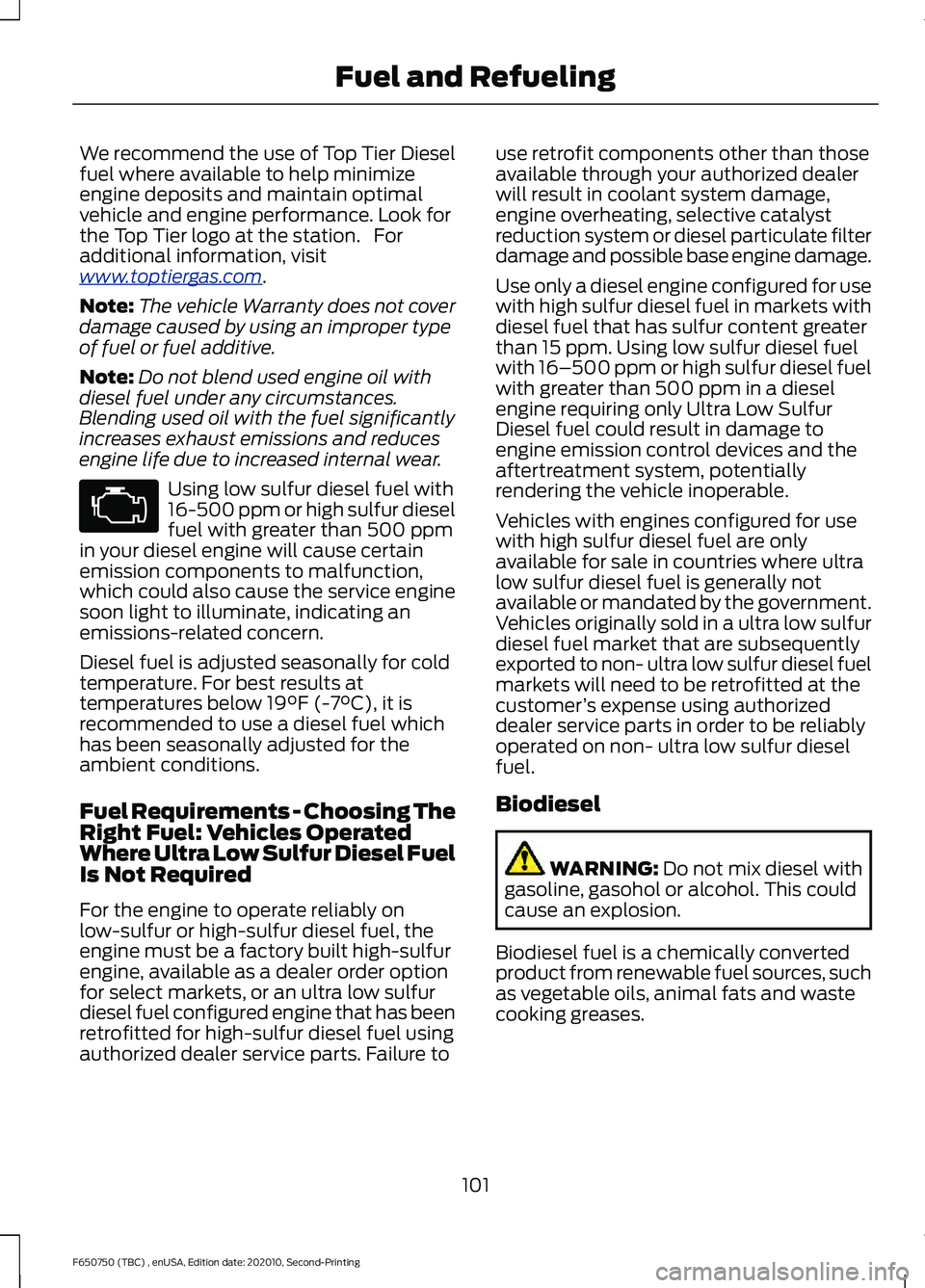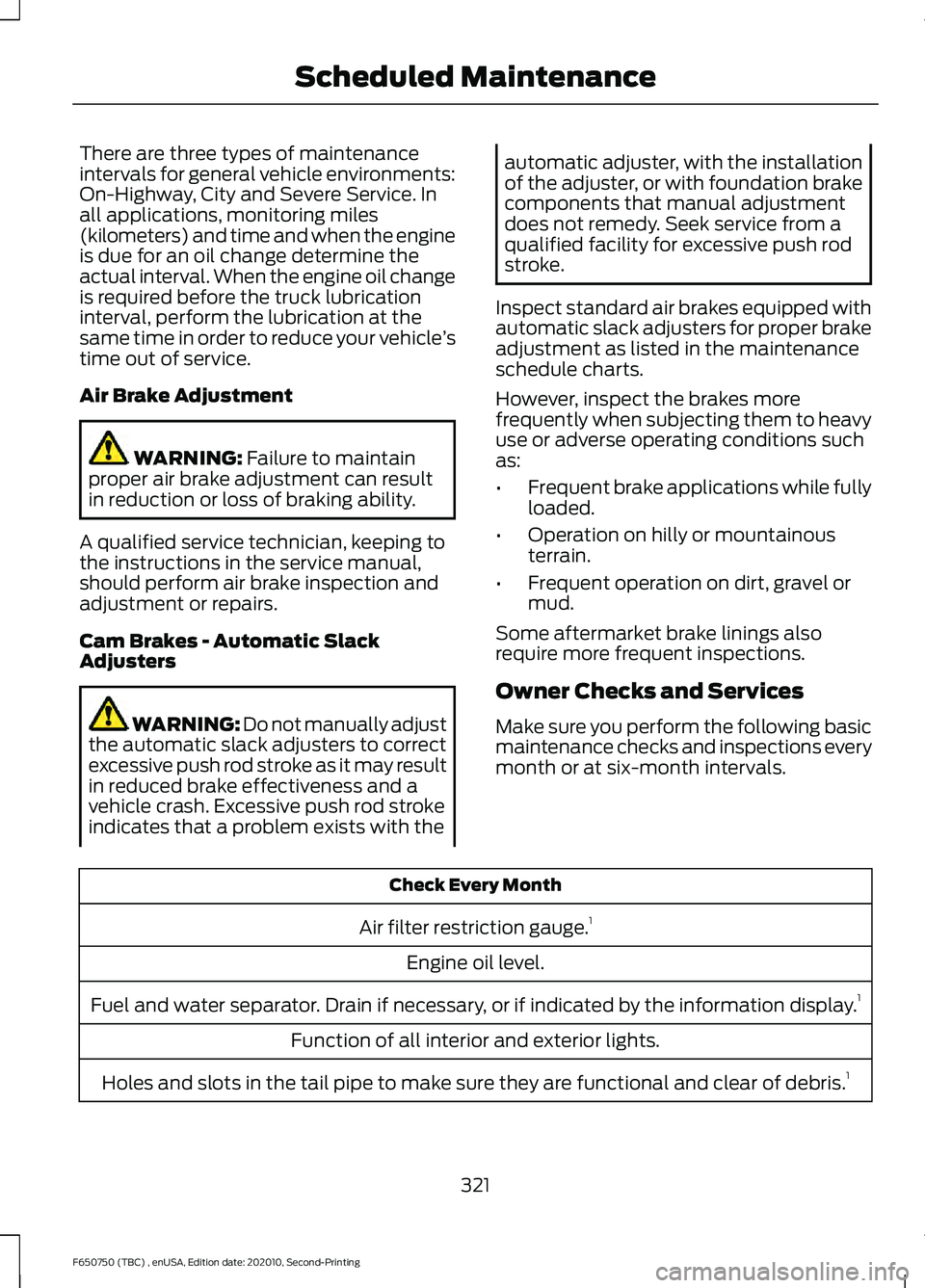2021 FORD F650/750 oil type
[x] Cancel search: oil typePage 14 of 390

Air conditioning system
Air conditioning system lubricant
type
Anti-lock braking system
Avoid smoking, flames or sparks
Battery
Battery acid
Brake fluid - non petroleum
based
Brake system
Brake system
Cabin air filter
Check fuel cap
Child safety door lock or unlock
Child seat lower anchor
Child seat tether anchor
Cruise control Do not open when hot
Engine air filter
Engine coolant
Engine coolant temperature
Engine oil
Explosive gas
Fan warning
Fasten seatbelt
Flammable
Front airbag
Front fog lamps
Fuel pump reset
Fuse compartment
Hazard flashers
Heated rear window
11
F650750 (TBC) , enUSA, Edition date: 202010, Second-Printing IntroductionE162384 E231157 E270480 E71340 E71880 E231160 E67017
Page 76 of 390

Truck Info
Truck Info
Gauge View
Digital Speedometer
Engine Information
Maintenance Monitor
Transmission Temperature
• Engine Information - Shows engine hours, engine idle hours and engine oil temp and
oil life.
Settings Settings
Select Your Setting
Lighting
Vehicle
Advanced
Settings
Easy Entry/Exit
Locks
Windows
Wiper Controls
Select Your Setting
Measurement
Units
Displ.
Settings
Temperature
Units
Tire Pressure
Language
INFORMATION MESSAGES
Note: Depending on your vehicle options
and instrument cluster type, not all of the
messages display or are available.
Additionally, the information display may
abbreviate or shorten certain messages. Press the RESET button to acknowledge
and remove some messages from the
information display. The information
display automatically removes other
messages after a short time.
You need to confirm certain messages
before you can access the menus.
73
F650750 (TBC) , enUSA, Edition date: 202010, Second-Printing Information Displays
Page 104 of 390

We recommend the use of Top Tier Diesel
fuel where available to help minimize
engine deposits and maintain optimal
vehicle and engine performance. Look for
the Top Tier logo at the station. For
additional information, visit
www
.t op tier g a s. c om .
Note: The vehicle Warranty does not cover
damage caused by using an improper type
of fuel or fuel additive.
Note: Do not blend used engine oil with
diesel fuel under any circumstances.
Blending used oil with the fuel significantly
increases exhaust emissions and reduces
engine life due to increased internal wear. Using low sulfur diesel fuel with
16-500 ppm or high sulfur diesel
fuel with greater than 500 ppm
in your diesel engine will cause certain
emission components to malfunction,
which could also cause the service engine
soon light to illuminate, indicating an
emissions-related concern.
Diesel fuel is adjusted seasonally for cold
temperature. For best results at
temperatures below 19°F (-7°C), it is
recommended to use a diesel fuel which
has been seasonally adjusted for the
ambient conditions.
Fuel Requirements - Choosing The
Right Fuel: Vehicles Operated
Where Ultra Low Sulfur Diesel Fuel
Is Not Required
For the engine to operate reliably on
low-sulfur or high-sulfur diesel fuel, the
engine must be a factory built high-sulfur
engine, available as a dealer order option
for select markets, or an ultra low sulfur
diesel fuel configured engine that has been
retrofitted for high-sulfur diesel fuel using
authorized dealer service parts. Failure to use retrofit components other than those
available through your authorized dealer
will result in coolant system damage,
engine overheating, selective catalyst
reduction system or diesel particulate filter
damage and possible base engine damage.
Use only a diesel engine configured for use
with high sulfur diesel fuel in markets with
diesel fuel that has sulfur content greater
than 15 ppm. Using low sulfur diesel fuel
with 16–500 ppm or high sulfur diesel fuel
with greater than 500 ppm in a diesel
engine requiring only Ultra Low Sulfur
Diesel fuel could result in damage to
engine emission control devices and the
aftertreatment system, potentially
rendering the vehicle inoperable.
Vehicles with engines configured for use
with high sulfur diesel fuel are only
available for sale in countries where ultra
low sulfur diesel fuel is generally not
available or mandated by the government.
Vehicles originally sold in a ultra low sulfur
diesel fuel market that are subsequently
exported to non- ultra low sulfur diesel fuel
markets will need to be retrofitted at the
customer
’s expense using authorized
dealer service parts in order to be reliably
operated on non- ultra low sulfur diesel
fuel.
Biodiesel WARNING:
Do not mix diesel with
gasoline, gasohol or alcohol. This could
cause an explosion.
Biodiesel fuel is a chemically converted
product from renewable fuel sources, such
as vegetable oils, animal fats and waste
cooking greases.
101
F650750 (TBC) , enUSA, Edition date: 202010, Second-Printing Fuel and Refueling
Page 255 of 390

Follow the tire manufacturer's
recommended cold inflation pressure for
the tire size, load range (ply rating) and
steer axle loading typical for their operation
(each steer axle tire equals ½ steer axle
loading).
Special applications may warrant a setting
based on experience with the type of tire
operating loads and conditions. Radial tires
are more sensitive to toe-in setting than
bias ply tires. Fine tuning school bus
alignment to line-haul truck standards
does not drastically improve tire tread life.
STEERING SYSTEM
INSPECTION
WARNING: Failure to maintain the
steering system in proper condition can
cause reduced steering ability resulting
in property damage, personal injury or
death.
Note: Have any steering problems
immediately corrected by a qualified service
technician.
Ask your service technician to examine the
steering mechanism. Only minor
adjustments may be necessary.
Regular inspections should include:
• Checking the tie rod, drag link end
clamp bolts and ball joints for proper
tightness.
• Checking for installation and spread of
cotter pins and tightness of nuts at
both ends of the tie rod and drag link.
• Checking that the pitman arm (steering
arm at steering gear) mounting is tight
and locked. Check system for leaks or
hose chafing. Repair immediately, if
necessary. •
Maintaining proper steering gear and
power steering pump lubricant levels.
• Checking steering column joint bolts
and steering linkage, particularly for
body-to-chassis clearance.
Steering Column Joint Bolts
As a good maintenance practice, check
steering column joint bolt tightness every
60,000 mi (96,000 km)
or annually,
whichever occurs first. Do not overtighten
the bolts.
Hydraulic System
Whenever draining and refilling the power
steering's hydraulic system for any reason,
bleed air from the system before returning
the vehicle to service. Failure to bleed the
hydraulic system properly can result in
degradation of power system performance.
Consult an authorized dealer who is aware
of the proper procedures for filling and
bleeding the system.
SUSPENSION SYSTEM
INSPECTION
Note: Do not adjust air suspension height
to any setting other than the specified
setting. Altering the height setting changes
the driveline angle and may result in
unwarrantable component damage, such
as transmission component damage.
Verify drive axle air suspension height and
height control valve performance at engine
oil change intervals.
Periodically check:
• Condition of spring leaves for evidence
of fatigue, bending or breakage.
• Condition of suspension mounting
brackets and bushings.
• Torque rod mounting fasteners for
tightness.
252
F650750 (TBC) , enUSA, Edition date: 202010, Second-Printing Maintenance
Page 324 of 390

There are three types of maintenance
intervals for general vehicle environments:
On-Highway, City and Severe Service. In
all applications, monitoring miles
(kilometers) and time and when the engine
is due for an oil change determine the
actual interval. When the engine oil change
is required before the truck lubrication
interval, perform the lubrication at the
same time in order to reduce your vehicle
’s
time out of service.
Air Brake Adjustment WARNING: Failure to maintain
proper air brake adjustment can result
in reduction or loss of braking ability.
A qualified service technician, keeping to
the instructions in the service manual,
should perform air brake inspection and
adjustment or repairs.
Cam Brakes - Automatic Slack
Adjusters WARNING: Do not manually adjust
the automatic slack adjusters to correct
excessive push rod stroke as it may result
in reduced brake effectiveness and a
vehicle crash. Excessive push rod stroke
indicates that a problem exists with the automatic adjuster, with the installation
of the adjuster, or with foundation brake
components that manual adjustment
does not remedy. Seek service from a
qualified facility for excessive push rod
stroke.
Inspect standard air brakes equipped with
automatic slack adjusters for proper brake
adjustment as listed in the maintenance
schedule charts.
However, inspect the brakes more
frequently when subjecting them to heavy
use or adverse operating conditions such
as:
• Frequent brake applications while fully
loaded.
• Operation on hilly or mountainous
terrain.
• Frequent operation on dirt, gravel or
mud.
Some aftermarket brake linings also
require more frequent inspections.
Owner Checks and Services
Make sure you perform the following basic
maintenance checks and inspections every
month or at six-month intervals. Check Every Month
Air filter restriction gauge. 1
Engine oil level.
Fuel and water separator. Drain if necessary, or if indicated by the information display. 1
Function of all interior and exterior lights.
Holes and slots in the tail pipe to make sure they are functional and clear of debris. 1
321
F650750 (TBC) , enUSA, Edition date: 202010, Second-Printing Scheduled Maintenance
Page 381 of 390

Auxiliary Switches........................................315
Upfitter Interface Module................................ 316
Axle Inspection..............................................251
Front Axle............................................................... 251
B
Battery See: Changing the 12V Battery..................... 239
Bonnet Lock See: Opening and Closing the Hood...........213
Booster Seats
..................................................32
Types of Booster Seats...................................... 33
Brake Fluid Check.........................................237 Brake Fluid Service Interval............................ 238
Brakes...............................................................130 General Information.......................................... 130
Brake System Inspection..........................248 Air Brakes.............................................................. 249
Driveline Parking Brake..................................... 251
Hydraulic Brakes................................................ 250
Breaking-In......................................................179
Bulb Specification Chart
..........................305
C
Canceling the Set Speed...........................155
Capacities and Specifications - 6.7L Diesel
............................................................288
Air Conditioning System................................. 288
Alternative Engine Oil for Biodiesel Fuel Blends (B20 Max)......................................... 291
Alternative Engine Oil for Extremely Cold Climates............................................................ 291
Alternative Engine Oil for Severe Duty Service............................................................... 292
Alternative Rear Axle Fluid for Severe Duty Service.............................................................. 296
Automatic Transmission................................ 288
Diesel Exhaust Fluid (DEF) Tank.................293
Engine Coolant................................................... 289
Engine Oil............................................................. 290
Front Wheel Bearing Oil.................................. 295
Fuel Tank............................................................... 292
Grease.................................................................... 293
Hydraulic Brake System.................................. 293
Locks...................................................................... 294
Power Steering System................................... 294Rear Axle...............................................................
295
Washer Reservoir............................................... 296
Capacities and Specifications - 7.3L..................................................................297
Air Conditioning System.................................. 297
Alternative Engine Oil for Extremely Cold Climates.......................................................... 300
Alternative Rear Axle Fluid for Severe Duty Service.............................................................. 304
Automatic Transmission................................ 298
Engine Coolant................................................... 299
Engine Oil............................................................. 299
Front Wheel Bearing Oil.................................. 303
Fuel Tank............................................................... 301
Grease..................................................................... 301
Hydraulic Brake System................................... 301
Locks...................................................................... 302
Power Steering System................................... 302
Rear Axle............................................................... 303
Washer Reservoir.............................................. 304
Capacities and Specifications
.................281
Car Wash See: Cleaning the Exterior.............................. 256
Catalytic Converter
.......................................110
On-Board Diagnostics (OBD-II)...................... 111
Readiness for Inspection and Maintenance (I/M) Testing...................................................... 111
Changing a Bulb
...........................................243
Brake Lamp, Rear Lamp, Rear Direction
Indicator, License Plate Lamp and
Reverse Lamp................................................ 244
Front Clearance and Identification Lamp.................................................................. 243
Headlamp Bulbs................................................ 243
Changing a Fuse...........................................201 Fuses....................................................................... 201
Changing a Road Wheel............................277 Tire Change Procedure..................................... 277
Changing the 12V Battery.........................239 Battery Management System (If
Equipped)....................................................... 240
Changing the Engine Air Filter - 6.7L Diesel..............................................................221
Air Filter Replacement...................................... 222
Air Filter Restriction Gauge.............................. 221
Changing the Engine Air Filter - 7.3L..................................................................223
378
F650750 (TBC) , enUSA, Edition date: 202010, Second-Printing Index